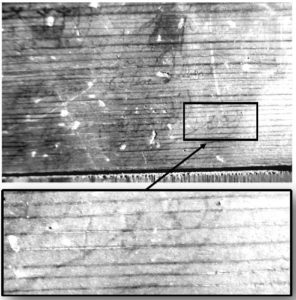Earlier this year we promised to address some historical graffiti and the remaining questions raised though our forensic study of the stone side of the house. To understand how these remaining questions have been formulated, we need to first discuss the limits of what our study can reveal. It is worth noting that we have called these investigations a forensic study. Forensic science is normally used to help criminal investigators uncover and interpret legally admissible physical evidence from a crime scene and to determine what happened at that place. In large measure what we have been doing at the Stone House has been similar to what crime scene investigators do in their work. In both cases the effort involves uncovering evidence that has, at times, been deliberately concealed or inadvertently left behind by those involved in an action or an event. In both cases the deliberate, or unwitting, destruction of evidence as well as inconclusive discoveries or ambiguous physical details can lead to reasonable doubts about a proposed scenario of events. In the case of the Stone House, these remaining questions are not so much about if things were done, but more about when things were done.
In our previous update about our forensic work we also introduced what we discovered behind a dado panel on the east wall of the stone side of the structure. Behind this paneling we found that most of the plaster was missing and that the stones there had been re-laid after the dado paneling was installed. The essence of this discovery was that there is a definite relationship between the time the dado panel was installed (it coming first) and the subsequent date the rear stone wall above the bulkhead entrance was re-laid. The stones laid behind the dado paneling also implied that the rear window on the east wall had been raised higher in that wall so that the dado panel could fit below it. Therefore, theoretically, if we can date the time that the rear cellar entrance was created, we could also get a better idea about when the dado panels were installed. As we have addressed in the past, and again in our previous post, there is a stone in the exterior wall with “1828” pecked into its facial surface above that bulkhead entrance and to the left of that window. If this date stone tells us when that rear wall was reworked for the installation of the back bulkhead entrance, then we also can be relatively sure that the dado panels inside were in place by 1828.
The problem is that there is also graffiti on the back of one of the dado panels from the west (front or street-side) wall. Examination of all these panels has indicated that they were originally cabinet doors constructed with mortise-and-tenon joints. When they were made into dado panels, they were cut down and nailed together with machine-made cut nails that were typically used between 1820 and 1890. Some of the graffiti in question appears to date to the time when the dado panels were still being used as cabinet doors. One panel has the names of Ellis Long, R. Wells, and A. Pitman. These individuals were contemporaries who lived in Stephensburg during the later half of the 1700s and the early decades of the 1800s. There were two men with the name Ellis Long. The father who lived from 1758 to 1837 was likely the one that inscribed this graffiti. The “R. Wells” was most likely Richard Wells, who lived from 1779 to 1846, and the “A. Pitman” was most likely Andrew Pitman (the potter) who lived from 1760 to 1838. These were all prominent businessmen in Stephensburg at the same time that Henry Jackson owned the Stone House from 1802 to 1833.
The graffiti on another one of the old cabinet doors that makes up this same panel is less clear. It includes doodling and what appears to be a signature followed by a date. The most discernible part of this graffiti is what appears to be the year 1837 or 1887. (See images below.) Could this mean that the dado panels were installed after this inscription was made, or could this inscription date to a time when the panel was temporarily removed by a worker? We may never know, but we are continuing to work on deciphering this inscription in hopes that it may tell us more. We also continue to prepare to install a new roof. In our next post we will address what this new roof will be like.

